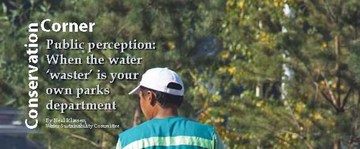Conservation Corner: Public perception – When the water ‘waster’ is your own parks department

The largest water consumer of the City of Kelowna water utility is the city’s own parks department. I suspect this is the same for many municipalities across the province.
This is hardly earth-shattering news. When one considers the number of parks, sports fields, playgrounds, boulevards, civic properties and miscellaneous green spaces that the municipal parks departments are responsible for maintaining, it should come as no surprise that they use a lot of water.
Where it becomes interesting is in cities with aggressive water conservation programs. Are parks departments expected to follow the same watering restrictions as residents? If the municipality is metered, do parks departments pay the same rates as everyone else? If residents are asked to cut back and conserve, are parks departments asked to do the same?
Sometimes parks’ watering practices seem to fly in the face of common sense, and when the public perceives that a city department is not practicing what it preaches, they can get downright indignant. But, it turns out that most parks departments in BC are doing a pretty good job when it comes to water conservation. There are two situations, however, that generate lots of spirited telephone calls from residents accusing parks departments of ‘wasting’ water.
Situation #1: Why does the parks department water during the day? In some cases, irrigation timers are affected by power outages, and it takes time for staff to correct the problem. In the meantime, some sprinklers may come on during the day.
In other cases, such as sports fields, the turf takes such a beating that it constantly has to be fertilized and reseeded. It takes a certain amount of water to maintain a sports field, and the water has to be delivered when the fields are not in use. Sometimes, the only time to do this is during the day.
Kelowna’s Parks Department faces a unique challenge at the downtown City Park: vandalism. The department has learned through bitter experience not to start irrigating until well after the bars are closed and the patrons have staggered home. It takes four or five hours to cycle through all the zones, so, inevitably, the sprinklers are still on when people start arriving for work in the morning.
In each of these cases, the reasoning behind the practice is sound, but the optics are terrible. Kelowna residents have a heightened awareness of the need to conserve water, so when they see the City ‘wasting’ water in this manner, they mutter to each other, write letters to the editor, and make phone calls to the water conservation office.
Situation #2: Why doesn’t the parks department follow the same watering restrictions I have to? Many parks departments do follow their city’s own watering restrictions, especially in the Lower Mainland, where irrigation is often just a supplement to rainfall. In the dry interior, it is a little different.
In one interior municipality, residential lawn watering is banned on Mondays to allow the reservoirs to recharge. That is why some residents of this town go ballistic when they see the parks department watering on Mondays. However, there is a reason behind the town’s watering practice: it cannot possibly water the parks on the weekends because they are full of people. By the time Monday rolls around, the turf is in desperate need of water. So the sprinklers come on, and the phone lines light up.
I have a great deal of sympathy for parks departments. When it comes to water conservation, they have to find a balance between public expectations of the parks’ aesthetics and the limitations of their water supply. Sometimes that is not as easy as a walk in the park.
Authors Note: Some of the information in this column comes from my own research for a Masters thesis entitled A Walk in the Park: Measuring Water Conservation Efforts in BC’s Municipal Green Spaces. I’ve learned some interesting stuff that I will share in future columns.
By Neal Klassen, BCWWA “Watermark” contributor
Posted June 2008
Originally published in the Summer 2007 issue of Watermark Magazine, the official publication of the British Columbia Water & Waste Association (BCWWA).

